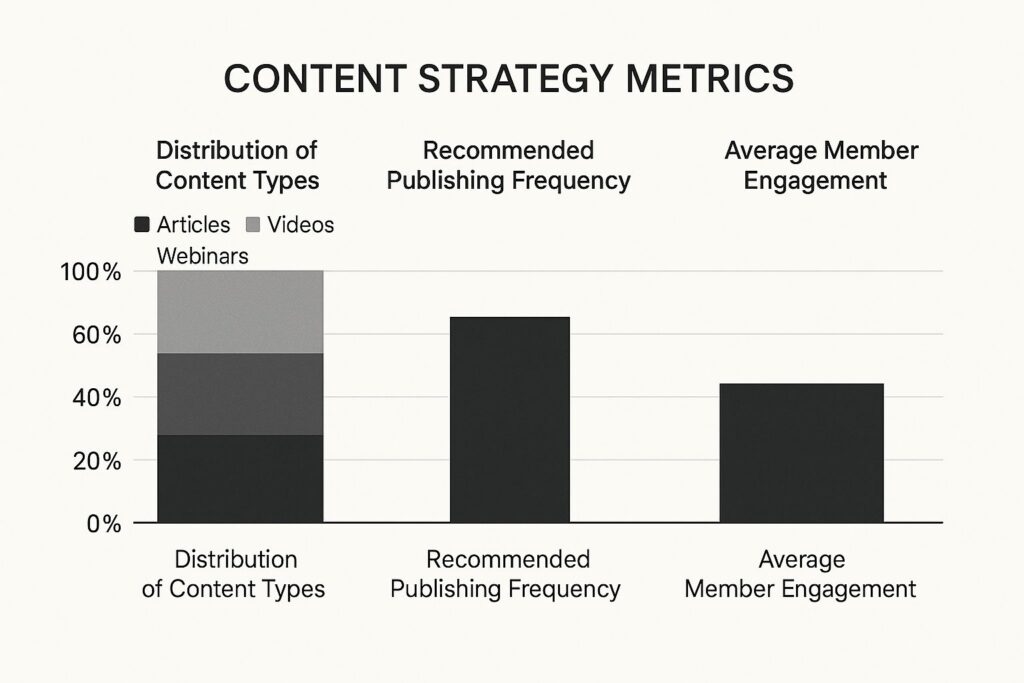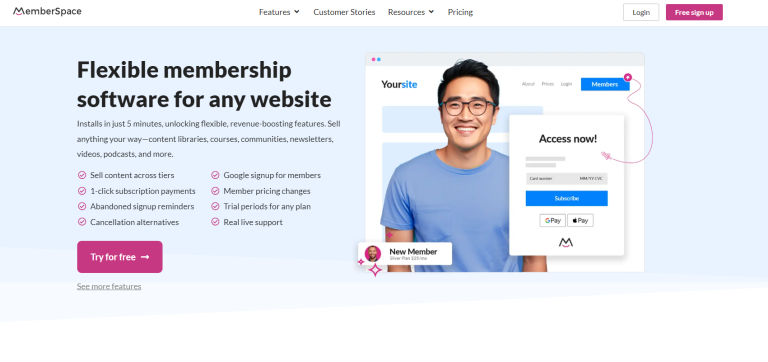Build a Membership Site from the Ground Up

If you want to get started with a membership site, you first need a crystal-clear idea of the value you’re going to offer. From there, you’ll pick a platform, like WordPress or an all-in-one solution, and then hammer out your content and pricing strategy.
It’s a powerful business model that can turn one-time customers into a long-term, loyal community by delivering exclusive content and recurring value.
Why a Membership Site Is a Game Changer
Before we jump into the nuts and bolts, let’s talk about why this model is so effective. I’ve seen it firsthand. It can completely change the DNA of a business, pulling it away from the constant, exhausting hustle for the next sale.
The single biggest shift is the move to predictable, recurring revenue. Instead of the feast-or-famine cycle that plagues so many online businesses, memberships give you a stable income stream you can actually count on.
That stability is huge. It lets you plan for the long term, reinvest in your business, and focus on what really matters: serving your audience.
Building a Loyal Community
A membership site does more than just bring in cash. It helps you build a genuine, thriving community around your work. People who join are investing in a shared interest and connecting with others who get it.
This creates a sense of belonging that a simple email list or a social media following just can’t touch. You’re carving out a dedicated space where your most engaged followers can gather, learn, and interact directly with you.
This deeper connection has a real impact on your bottom line. In fact, businesses using membership models can see up to 60% higher customer retention rates compared to those relying on one-off sales. It makes sense, since ongoing value keeps people subscribed and engaged for the long haul. You can find more insights on membership models over at femaleswitch.com.
A membership transforms your audience from passive consumers into active participants. They become advocates for your brand because they feel like they’re part of something special.
Creating a Resilient Business
Ultimately, a membership makes your entire business more resilient. You’re building a tangible asset with this model. This helps you weather market turbulence and algorithm mood swings because you own the direct relationship with your audience.
Here are some of the core benefits you can expect:
- Direct Audience Connection: You own the platform and the relationship. No more worrying about a social media channel disappearing overnight.
- Higher Customer Lifetime Value: A member who sticks around for months or years is infinitely more valuable than a single-purchase customer.
- Valuable Feedback Loop: Your community becomes an incredible source of feedback, helping you create better content and products they want.
Thinking about your business this way changes everything. You start focusing on long-term value and relationships, which is the only real foundation for a sustainable, successful venture.
Choosing Your Platform and Tech Stack
Alright, you’re fired up about the why, and now it’s time to tackle the how. Deciding on the right tools to build your membership site can feel like the most intimidating part of the whole process. I get it. But your “tech stack,” just a fancy term for the tools you use, doesn’t have to be a nightmare. Getting it right from the start means you can focus on your members, not on technical headaches.
The decision really boils down to two main paths. You can use a flexible plugin on your existing WordPress site or go with a dedicated, all-in-one platform. There’s no single “best” answer here, only what’s best for you, your budget, and how comfortable you are getting your hands dirty with technology.
WordPress Plugins vs All-in-One Platforms
If you already have a WordPress site up and running, using a membership plugin is often the most direct route. It keeps everything under one roof and gives you an incredible amount of control over the look, feel, and functionality of your member experience. You’re in the driver’s seat.
On the other hand, all-in-one platforms are designed to make your life easier. Period. They handle all the backend stuff like hosting, security, and updates, so you can just focus on creating amazing content and building your community.
This convenience usually comes at a higher monthly cost, but for many creators, it’s a price well worth paying for the peace of mind.
To make this clearer, let’s look at how they stack up head-to-head.
Membership Platform Comparison
This table offers a quick, head-to-head look at the most popular platform types. It’s designed to help you choose the right path for your specific needs, budget, and how much you enjoy (or dread) dealing with tech.
| Platform | Best For | Ease of Use | Approx. Cost |
|---|---|---|---|
| WordPress + Plugin | Creators who want full control and endless customization. | Medium to Hard | $150 – $400+ per year |
| All-in-One Platform | Beginners or those who prefer a simple, hands-off solution. | Easy | $50 – $300+ per month |
| Custom Build | Businesses with large budgets and highly unique needs. | Very Hard | $5,000 – $25,000+ |
As you can see, there’s a clear trade-off between control, simplicity, and cost. If you’re just starting out, an all-in-one platform can get you launched in a weekend. A WordPress setup, however, offers a powerful foundation that can grow with you for years to come. There’s no wrong choice, just the right choice for right now.
Your content strategy, what you’ll be creating and how often, should also influence your platform choice.

This just shows that a balanced mix of content types is key to keeping members engaged. That means your platform needs to be able to handle videos, text, downloads, and community features without breaking a sweat.
Essential Tools for Your Tech Stack
Beyond the core platform, you’ll need a few other key tools to make sure everything runs smoothly. Don’t worry, you don’t need a dozen different subscriptions right away. You can start with just the essentials.
- Payment Gateway: This is how you’ll get paid. Simple as that. Stripe and PayPal are the undisputed champs here, and they’re trusted by millions. Pretty much any membership platform you choose will integrate seamlessly with them.
- Email Marketing Service: This one is absolutely non-negotiable. You need a reliable way to communicate with your members, send out newsletters, and welcome new subscribers. Tools like Mailchimp, ConvertKit, or ActiveCampaign are all fantastic for this.
- Community Forum (Optional but Recommended): While not essential for every single membership, a dedicated community space can dramatically boost engagement and reduce churn. This could be a simple forum on your site, a private Facebook Group, or a slick, dedicated platform like Circle.so.
The membership model has absolutely exploded in popularity. Recent data shows that a staggering 66.8% of membership sites were created in just the last three years. That’s a massive boom. It’s also interesting to see that while about two-thirds of sites target consumers (B2C), a growing number are successfully serving other businesses (B2B). You can dig into more fascinating membership site statistics and trends on uscreen.tv.
Making the Right Choice for You
So, how do you actually decide? Start by being brutally honest with yourself about your skills and priorities.
Are you comfortable tinkering with WordPress, or does the thought of dealing with plugins and updates give you a headache? How much of your time do you want to spend on the tech versus actually creating content for your members?
Your tech stack should empower you, not become a roadblock. The goal is to choose tools that get out of your way and let you do what you do best: serve your members.
If you’re still feeling stuck, our team put together an in-depth guide to help you compare the top players in the market. You can learn more about finding the best membership site platform in our detailed article. It breaks down all the top choices and will help you find the perfect fit for your specific vision.
Ultimately, the right choice is the one that gets you launched and allows you to deliver a fantastic experience for your members without causing you constant stress. Don’t overthink it. Pick a path and get started.
Developing Your Content and Pricing Strategy

This is where the real magic happens. A slick platform is nice, but it’s the value inside that convinces people to stick around. Your members are signing up because they believe you have something special to offer them. So let’s get crystal clear on what that is and what it’s worth.
Thinking about your content strategy shouldn’t be a source of stress. You just need to create things that solve a real problem, offer a shortcut, or bring a little joy to your ideal member. The goal is to build a mix of resources that keeps them excited to log in and see what’s new.
Brainstorming Your Membership Content
Let’s start by mapping out the kinds of value you can realistically provide. Don’t feel like you have to do everything at once. Pick a few that play to your strengths and feel manageable right out of the gate.
A great place to begin is with what I call “cornerstone content.” This is the foundational stuff that new members can dive into immediately to get a quick win. It could be a signature online course, a library of essential tutorials, or a robust collection of templates.
Here are a few popular content ideas to get your wheels turning:
Exclusive Articles or Tutorials: Go deeper than your public content. Share the insider tips, advanced techniques, or behind-the-scenes processes that only members get to see.
Video Content: This is a big one. You could offer in-depth training videos, live Q&A sessions, or short, practical tips. For content creators, understanding robust video paywall capabilities is crucial for monetizing exclusive video within your membership.
A Private Community: Sometimes the biggest value is the connection between members. A private forum or chat group lets people network, ask questions, and support each other on their journey.
Downloadable Resources: Think checklists, worksheets, templates, or ebooks. These are tangible assets that provide immediate value and make your members’ lives easier.
Remember, every single piece of content should be aimed at helping your members achieve a specific outcome. Whether that’s learning a new skill, growing their business, or mastering a hobby, your content should always move them one step closer to their goal.
Setting Your Membership Pricing
Pricing can feel like a guessing game, but it doesn’t have to be. Your price sends a clear message about the value you’re providing, so you want to get it right. It’s all about finding that sweet spot where members feel like they’re getting an incredible deal, and you’re being compensated fairly for your hard work.
A common and highly effective approach is to offer tiered pricing. This lets you serve different segments of your audience with different needs and budgets.
For instance, you could structure your tiers like this:
- Tier 1 (Basic): Grants access to your core content library and community forum. This is a great, low-barrier entry point.
- Tier 2 (Pro): Includes everything in Tier 1, plus monthly live Q&A calls and exclusive new content drops.
- Tier 3 (VIP): All of the above, plus direct access to you through one-on-one coaching or a small mastermind group.
Your pricing strategy should reflect the transformation you’re offering. People are paying for a result, not just content. Price your membership based on the value of that outcome.
You’ll also need to decide between monthly and annual plans. I highly recommend offering both. A monthly plan offers flexibility for new members, while an annual plan (usually with a 10-20% discount) encourages commitment and provides you with a nice chunk of cash flow upfront.
Creating a Simple Content Calendar
Consistency is the name of the game when you want to build a membership site that lasts. Nothing kills momentum faster than a member logging in and seeing that nothing new has been added in weeks.
This is where a content calendar becomes your best friend. It doesn’t need to be complicated. A simple spreadsheet is all you need.
Just map out what you plan to release each week or month. This keeps you accountable and gives your members something to look forward to. For instance, the first week of the month could be a new video tutorial, the second a live Q&A, the third a downloadable resource, and the fourth a member spotlight in the community.
Planning ahead like this takes the pressure off and ensures you’re always delivering fresh, exciting value that keeps your members happily subscribed for the long haul.
You’ve poured your heart and soul into creating incredible content and wrangling the tech. Now for the fun part: opening the doors. A great launch sets the tone for everything to come. It’s all about creating a wave of momentum that can carry you for months, making your very first members feel like they’re getting in on the ground floor of something special.
A successful launch isn’t some secret, complicated formula. You just need to be deliberate and tap into the audience you already have. Your email list, your social media followers, the folks who read your blog, these are your biggest assets. They already know you, like you, and trust you, which makes them the perfect first wave of members.
Building Pre-Launch Buzz
Your launch doesn’t kick off the day you flip the “join now” switch. It starts weeks, maybe even a month, before that. This is your time to drop hints, build curiosity, and get people genuinely excited for the moment they can finally get inside.
Think of it like a movie trailer. You’re giving them a sneak peek of the value you’ve created without revealing the whole plot. Share some behind-the-scenes glimpses of a piece of content you’re working on or the community platform taking shape. Run a poll on Instagram asking what they’d be most excited to learn in a private, supportive space.
These little teasers accomplish a few critical things:
- They validate your idea. If people are getting excited, you know you’re onto something good.
- They build your waitlist. Every teaser should point people to an email list where they can be the “first to know.” This list is pure gold on launch day.
- They create a sense of involvement. When people feel like they’ve been part of the journey, they’re far more invested in the outcome.
The Power of a Founding Member Launch
One of my all-time favorite strategies, especially when you first build a membership site, is what’s known as a “founding member” or “beta” launch. Instead of a big, splashy public opening, you invite a small, hand-picked group to join first, usually at a special lifetime discount.
This approach is brilliant for a few reasons. First off, it creates real scarcity and makes the offer feel exclusive. People love feeling like they’re on the inside track. Second, it gives you a small, manageable group of your most enthusiastic supporters to kick things off.
A founding member launch is about co-creating the membership experience with your most passionate supporters. Their feedback is pure gold.
This initial group becomes your feedback engine. They’ll help you spot technical glitches, tell you which content they love most, and give you ideas for what to create next. This allows you to iron out all the kinks before opening the doors to a wider audience, making sure every new member has an amazing experience from day one.
Opening the Doors and Onboarding
When launch day finally arrives, your laser focus should be on that email list you’ve been building. These are the people who have literally raised their hands and said, “I’m interested!” Send them a short series of emails over a few days reminding them of the value, highlighting the exclusive founding member offer, and making it crystal clear that the special pricing is a one-time deal.
But once someone signs up, the real journey has just begun. Those first few days are critical for making them feel welcome and showing them exactly how to get value out of their subscription.
A clunky or confusing start is a fast track to cancellation. To make sure your new members stick around, you need a strong onboarding process. You can explore some excellent user onboarding best practices to get ideas for creating a smooth welcome.
This could be as simple as a personal welcome video from you, a “first steps” checklist, or a dedicated “start here” section in your community. Platform-specific guidance can be a lifesaver here, too.
For instance, our team put together a detailed guide on how to launch a membership site using Squarespace that covers these exact steps. Your goal is simple: get them a quick win and make them feel right at home.
Keeping Members Engaged for the Long Haul

Getting someone to sign up for your membership is a huge win, but let’s be honest, that’s just the starting line. The real work, the part that decides if your site will thrive or fizzle out, is keeping those members happy, active, and subscribed month after month. This is all about retention.
You’ve moved past selling content. Now, you’re cultivating an experience. The goal is to build a space people feel genuinely connected to, a community they actually don’t want to leave. When you get this right, members stop seeing a monthly fee and start seeing an essential investment in their own success.
Building a Thriving Community
Your single most powerful retention tool? The community itself. People might join for your content, but they’ll stay for the connections they make. You have to be intentional about creating a place where members feel seen, heard, and supported.
Fostering that sense of belonging is non-negotiable. You can learn how to build a strong online community with some fantastic tips that are directly applicable here. It all boils down to sparking member-to-member interactions so the community doesn’t depend solely on you.
Here are a few practical ideas to get the conversation flowing:
- Weekly Prompts or Challenges: Post a simple question or a small weekly challenge to get everyone involved. It could be anything from sharing a recent win to tackling a relevant task.
- Member Spotlights: Regularly feature a member and their work. This not only makes that person feel valued but also helps others put a face to the names in the community.
- Member-Only Events: Host live Q&A sessions, virtual coffee chats, or expert interviews just for your members. These events create shared experiences and give people a real reason to log in.
Your job is to be the host of the party, not the center of attention. Create the environment, provide the tools, and then step back and let your members connect with each other.
Making Engagement Fun with Gamification
Another fantastic way to boost activity is to sprinkle in some simple gamification. This is about using rewards and recognition to encourage the behaviors you want to see, like logging in, completing content, or jumping into discussions.
This is a major evolution in membership programs. For instance, Ulta Beauty’s gamified loyalty program, GlamXplorer, saw an incredible 86% weekly return rate among participants. On average, they engaged six times per week. That shows just how powerful these simple mechanics can be.
You can easily apply these same ideas when you build a membership site.
Simple Gamification Ideas
- Award Badges: Give members digital badges for hitting milestones, like their one-year anniversary, finishing a course, or helping.
- Create a Leaderboard: If it fits your community’s vibe, a simple leaderboard tracking participation can spark some fun, friendly competition.
- Unlockable Content: Reward your most active members with early access to new content or bonus materials once they hit a certain level of engagement.
These small touches can make a huge difference. At the end of the day, keeping members for the long haul comes down to two things: delivering consistent value and fostering genuine human connection. Our team has also put together a more detailed guide with additional membership retention strategies that you might find helpful. By focusing on both great content and a great community, you create an experience that becomes an indispensable part of your members’ lives.
Still Have Questions? Let’s Tackle Them.
To wrap things up, let’s go through some of the most common questions that pop up when people start thinking seriously about building a membership site. I’ve heard these hundreds of times, and getting them answered upfront can save you a ton of guesswork down the road.
How Much Does It Cost to Build a Membership Site?
This is always the first question, and the honest-to-goodness answer is: it depends. The cost can be anything from a couple of pizzas a month to a serious investment, and it all comes down to the path you choose. You can absolutely get started on a shoestring budget if you’re willing to roll up your sleeves.
The DIY route, especially if you already have a WordPress site, is your most budget-friendly option. Your main costs will look something like this:
- Hosting: Plan on about $15-$30 per month for a service that won’t crash on you.
- Membership Plugin: A good premium plugin will likely run between $150-$400 per year.
- Email Marketing: You can start for free, but expect this to grow to $30-$50+ a month as your list gets bigger.
- Payment Processor Fees: These are pretty standard. Think 2.9% + $0.30 per transaction for platforms like Stripe or PayPal.
On the other end of the spectrum are the all-in-one platforms. These guys bundle everything together for a single monthly fee, which can range from $50 to over $300. Yes, the monthly sticker price is higher, but you’re paying for convenience, dedicated support, and the confidence that everything just works together without you needing to play tech support.
How Do I Get My First 100 Members?
Getting those first members can feel like pushing a boulder uphill, but it’s more doable than you think. The trick is to forget about attracting strangers for now. Instead, lean into the audience and trust you’ve already built, no matter how small it might seem.
My go-to strategy for this is a “founding member” launch. It’s simple. You offer a special, one-time-only discount to a small group of people from your existing email list or social media following. This creates a bit of urgency and makes them feel like they’re insiders getting in on the ground floor of something special.
Your first 100 members are your most important asset. They aren’t just customers. They are your co-creators. They will give you the raw, honest feedback you need to shape the future of your community.
Another powerful tactic is to collaborate. Find someone else in your niche who serves a similar audience (but isn’t a direct competitor) and pitch a joint webinar or a content swap. It’s one of the fastest ways to get in front of a new, highly relevant audience that’s already warmed up to your topic.
What Is the Best Way to Prevent Cancellations?
Fighting churn, the industry term for cancellations, starts the second someone signs up. Your first line of defense is a killer onboarding process. If a new member feels lost, confused, or overwhelmed in their first 48 hours, their finger is already hovering over the cancel button.
You have to make it ridiculously easy for them to get a quick win. This could be a “Start Here” video that walks them through the site, a simple checklist of their first three steps, or a welcome thread in the community that prompts them to introduce themselves. The goal is to make them feel at home and show them immediate value.
After that, it all comes down to consistency.
- Deliver New Value: Don’t let things get stale. Regularly add fresh content, host live Q&As, or spark new discussions. Give people a reason to keep logging in.
- Build Community: Actively encourage and facilitate member-to-member connections. When people form real relationships, they’re paying to stay with their friends, not just for content.
- Ask for Feedback: Don’t guess what your members want. Check in with them periodically with a quick survey. Ask what they love and what they wish was different. This makes them feel heard and helps you fix small problems before they become cancellation-worthy.
Should I Offer a Free Trial for My Membership?
Ah, the great free trial debate. There’s no simple yes or no here. Offering a free trial is a fantastic way to lower the barrier to entry and get more people to kick the tires. It completely removes the risk for potential members, which can give your sign-up numbers a serious boost.
But there’s a catch. Free trials often attract people who are just looking for freebies, with zero intention of ever pulling out their credit card. This can lead to a sky-high cancellation rate the moment the trial ends, which can be pretty demoralizing.
A brilliant alternative I’ve seen work incredibly well is the low-cost paid trial, think a 7-day trial for just $1. The simple act of asking for a tiny financial commitment works wonders for filtering out the tire-kickers and attracting a more serious member.
Another solid option is a 30-day money-back guarantee. This still removes the risk for the buyer, but it ensures you’re only dealing with people who are serious enough to make the initial payment in the first place.






